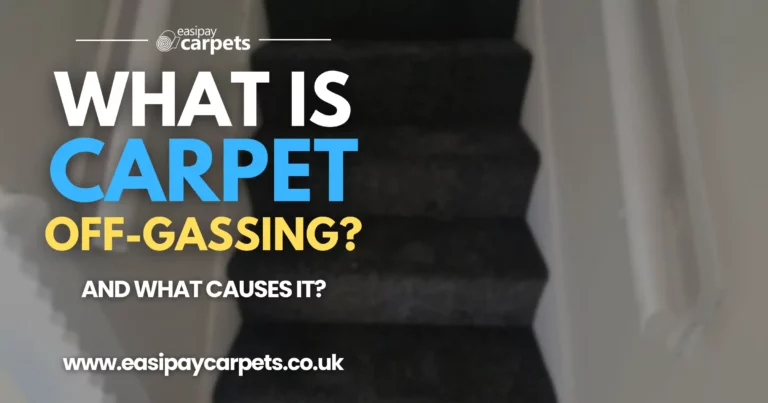

Understanding Carpet Off-Gassing: What You Need to Know
When you unroll a new carpet in your home, you might notice a distinct smell. This is often described as ‘new carpet smell,’ but what you’re actually smelling are volatile organic compounds (VOCs) being released into the air in a process known as off-gassing. Understanding this phenomenon is crucial, especially if you are decorating a space that will be used by young children, people with allergies, or pets. In this post, we’ll delve into what carpet off-gassing is, why it happens, and how you can minimise its impact on your indoor air quality.
What is Carpet Off-Gassing?
Off-gassing refers to the release of airborne particulates or gases from certain materials or products. In the context of carpets, off-gassing is the emission of VOCs that occur mainly from the adhesives and the backing materials used in carpet manufacturing. VOCs can include a variety of chemicals, some of which may have short- and long-term adverse health effects.
Common Sources of VOCs in Carpets
- Adhesives: Used to bind the carpet fibres to the backing.
- Dyes and stain protectors: Applied for colour and to repel stains.
- Backing materials: Often made from synthetic latex or PVC.
Health Implications of Carpet Off-Gassing
The VOCs released during off-gassing can contribute to a range of health issues, particularly in individuals who are sensitive to chemicals. Symptoms can include:
- Headaches
- Dizziness
- Nausea
- Allergic skin reactions
- Eye, nose, and throat irritation
- Asthma exacerbation
Long-term exposure to certain VOCs, in higher concentrations, has been linked to more serious health effects, but the levels typically found in home environments are much lower.
How to Minimise Carpet Off-Gassing
1. Choose Low-VOC Products
When purchasing new carpets, look for labels that indicate low VOC emissions. Certifications like Green Label Plus from the Carpet and Rug Institute indicate that a product has met stringent criteria for VOC emissions.
2. Ensure Good Ventilation
After installing new carpet, increase ventilation in the space by opening windows and using fans to get a draught going. This helps disperse the emitted gases more quickly and reduces the concentration in the indoor air. If you can open a window at the front of the house and one at the rear then you’re likely to create a breeze that can travel in and out of the home, taking VOC emissions with it!
3. Use Air Purifiers
Consider using an air purifier with activated carbon filters to help absorb some of the chemicals released during off-gassing.
4. Opt for Natural Fibre Carpets
Carpets made from natural fibres like wool, jute, or sisal tend to off-gas less than synthetic materials.
5. Regular Cleaning
Regular vacuuming with a HEPA filter vacuum cleaner can help reduce any particles that linger after initial off-gassing.
Conclusion
While carpet off-gassing can be a concern, understanding what it entails and how to manage it can help you maintain a healthy indoor environment. Opting for low-VOC carpet options and ensuring adequate ventilation during and after installation are key strategies to reduce exposure.
By making informed choices and taking the right precautions, you can enjoy the comfort and aesthetic of new carpets without compromising your indoor air quality.
Easipay Carpets can help you get brand new flooring without the high up-front cost – by simply letting you spread the cost of the flooring over time instead. There’s no interest on our plans so you aren’t spending a penny more than you would buying it outright and we include underlay, door trims, carpet grippers and laminate beading for free. Prices start from just £10 per week!
It starts with a free home appointment and quote, to get booked in at a time that suits you, tap the “Get Started” button below and fill out the contact form!
Still Got Questions? Here's 10 FAQs!
Typically, most off-gassing occurs within the first 72 hours after installation but can continue at lower levels for up to a few weeks.
Yes, carpet pads can also emit VOCs, especially those made from bonded urethane foam, which is often made from recycled materials.
For most people, the low levels of VOCs emitted are not dangerous and will dissipate over time. However, individuals with chemical sensitivities or respiratory conditions may be more affected.
It is difficult to eliminate off-gassing entirely, but choosing carpets with natural fibres and low VOC emissions can significantly reduce it.
Cleaning can help remove some VOCs but the most effective method is increasing ventilation in the area.
Yes, as carpets age, the amount of VOCs they emit decreases significantly.
You can use VOC meters or indoor air quality monitors available on the market to check the levels of VOCs in your home.
Alternatives include rugs made from natural materials, hardwood flooring, and tiles that do not emit VOCs.
No, the amount of VOCs emitted can vary based on the materials and chemicals used in manufacturing the carpet.
Yes, pets can be affected by VOCs, especially since they are closer to the floor. Choose pet-friendly, low-VOC carpets to ensure their safety.




